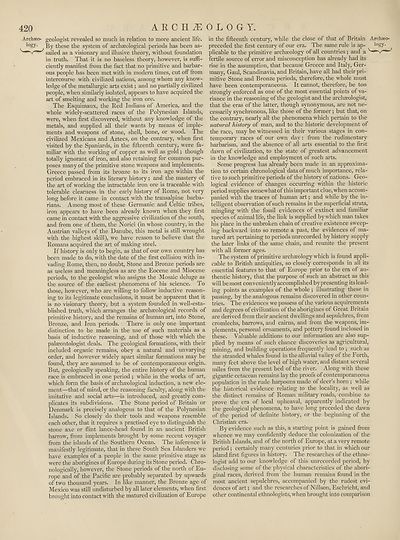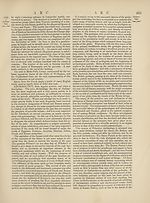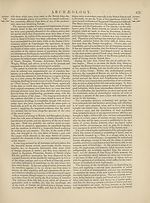Encyclopaedia Britannica > Volume 3, Anatomy-Astronomy
(428) Page 420
Download files
Complete book:
Individual page:
Thumbnail gallery: Grid view | List view

420 ARCH iEO LOG Y.
Archa;o- geologist revealed so much in relation to more ancient life.
logy- By these the system of archaeological periods has been as-
sailed as a visionary and illusive theory, without foundation
in truth. That it is no baseless theory, however, is suffi¬
ciently manifest from the fact that no primitive and barbar¬
ous people has been met with in modern times, cut off from
intercourse with civilized nations, among whom any know¬
ledge of the metallurgic arts exist; and no partially civilized
people, when similarly isolated, appears to have acquired the
art of smelting and working the iron ore.
The Esquimaux, the Red Indians of America, and the
whole widely-scattered races of the Polynesian Islands,
were, when first discovered, without any knowledge of the
metals, and supplied all their wants by means of imple¬
ments and weapons of stone, shell, bone, or wood. The
civilized Mexicans and Aztecs, on the contrary, when first
visited by the Spaniards, in the fifteenth century, were fa¬
miliar with the working of copper as well as gold; though
totally ignorant of iron, and also retaining for common pur¬
poses many of the primitive stone weapons and implements.
Greece passed from its bronze to its iron age within the
period embraced in its literary history; and the mastery of
the art of working the intractable iron ore is traceable with
tolerable clearness in the early history of Rome, not very
long before it came in contact with the transalpine barba¬
rians. Among most of these Germanic and Celtic tribes,
iron appears to have been already known when they first
came in contact with the aggressive civilization of the south,
and from one of them, the Norici (in whose country, in the
Austrian valleys of the Danube, this metal is still wrought
with the highest skill), we have reason to believe that the
Romans acquired the art of making steel.
If history is only to begin, as that of our own country has
been made to do, with the date of the first collision with in¬
vading Rome, then, no doubt, Stone and Bronze periods are
as useless and meaningless as are the Eocene and Miocene
periods, to the geologist who assigns the Mosaic deluge as
the source of the earliest phenomena of his science. To
those, however, who are willing to follow inductive reason¬
ing to its legitimate conclusions, it must be apparent that it
is no visionary theory, but a system founded in well-esta¬
blished truth, which arranges the archaeological records of
primitive history, and the remains of human art, into Stone,
Bronze, and Iron periods. There is only one important
distinction to be made in the use of such materials as a
basis of inductive reasoning, and of those with which the
palaeontologist deals. The geological formations, with their
included organic remains, obey a natural and unvarying
order, and however widely apart similar formations may be
found, they are assumed to be of contemporaneous origin.
But, geologically speaking, the entire history of the human
race is embraced in one period ; while in the works of art,
which form the basis of archaeological induction, a new ele¬
ment—that of mind, or the reasoning faculty, along with the
imitative and social arts—is introduced, and greatly com¬
plicates its subdivisions. The Stone period of Britain or
Denmark is precisely analogous to that of the Polynesian
Islands. So closely do their tools and weapons resemble
each other, that it requires a practised eye to distinguish the
stone axe or flint lance-head found in an ancient British
barrow, from implements brought by some recent voyager
from the islands of the Southern Ocean. The inference is
manifestly legitimate, that in these South Sea Islanders we
have examples of a people in the same primitive stage as
were the aborigines of Europe during its Stone period. Chro¬
nologically, however, the Stone periods of the north of Eu¬
rope and of the Pacific are probably separated by upwards
of two thousand years. In like manner, the Bronze age of
Mexico was still undisturbed by all later elements, when first
brought into contact with the matured civilization of Europe
in the fifteenth century, while the close of that of Britain Archaeo-
preceded the first century of our era. The same rule is ap- logy-
plicable to the primitive archaeology of all countries; and a
fertile source of error and misconception has already had its
rise in the assumption, that because Greece and Italy, Ger¬
many, Gaul, Scandinavia, and Britain, have all had their pri¬
mitive Stone and Bronze periods, therefore, the whole must
have been contemporaneous. It cannot, therefore, be too
strongly enforced as one of the most essential points of va¬
riance in the reasoning of the geologist and the archaeologist,
that the eras of the latter, though synonymous, are not ne¬
cessarily synchronous, like those of the former; but that, on
the contrary, nearly all the phenomena which pertain to the
natural history of man, and to the historic development of
the race, may be witnessed in their various stages in con¬
temporary races of our own day: from the rudimentary
barbarism, and the absence of all arts essential to the first
dawn of civilization, to the state of greatest advancement
in the knowledge and employment of such arts.
Some progress has already been made in an approxima¬
tion to certain chronological data of much importance, rela¬
tive to such primitive periods of the history of nations. Geo¬
logical evidence of changes occurring within the historic
period supplies somewhat of this important clue, when accom¬
panied with the traces of human art; and while by the in¬
telligent observation of such remains in the superficial strata,
mingling with the fossil evidences of extinct and familiar
species of animal life, the link is supplied by which man takes
his place in the unbroken chain of creative existence sweep¬
ing backward into so remote a past, the evidences of ma¬
tured art pertaining to periods unrecorded by history supply
the later links of the same chain, and reunite the present
with all former ages.
The system of primitive archaeology which is found appli¬
cable to British antiquities, so closely corresponds in all its
essential features to that of Europe prior to the era of au¬
thentic history, that the purpose of such an abstract as this
will be most conveniently accomplished by presenting its lead¬
ing points as examples of the whole ; illustrating these in
passing, by the analogous remains discovered in other coun¬
tries. The evidences we possess of the various acquirements
and degrees of civilization of the aborigines of Great Britain
are derived from their ancient dwellings and sepulchres, from
cromlechs, barrows, and cairns, and from the weapons, im¬
plements, personal ornaments, and pottery found inclosed in
these. Valuable additions to our information are also sup¬
plied by means of such chance discoveries as agricultural,
mining, and building operations frequently lead to ; such as
the stranded whales found in the alluvial valley of the Forth,
many feet above the level of high water, and distant several
miles from the present bed of the river. Along with these
gigantic cetacean remains lay the proofs of contemporaneous
population in the rude harpoons made of deer’s horn ; while
the historical evidence relating to the locality, as well as
the distinct remains of Roman military roads, combine to
prove the era of local upheaval, apparently indicated by
the geological phenomena, to have long preceded the dawn
of the period of definite history, or the beginning of the
Christian era.
By evidence such as this, a starting point is gained from
whence we may confidently deduce the colonization of the
British Islands, and of the north of Europe, at a very remote
period; certainly many centuries prior to that in which our
island first figures in history. The researches of the ethno¬
logist add to our knowledge of this unrecorded period, by
disclosing some of the physical characteristics of the abori¬
ginal races, derived from the human remains found in the
most ancient sepulchres, accompanied by the rudest evi¬
dences of art; and the researches of Nillson, Eschricht, and
other continental ethnologists, when brought into comparison
Archa;o- geologist revealed so much in relation to more ancient life.
logy- By these the system of archaeological periods has been as-
sailed as a visionary and illusive theory, without foundation
in truth. That it is no baseless theory, however, is suffi¬
ciently manifest from the fact that no primitive and barbar¬
ous people has been met with in modern times, cut off from
intercourse with civilized nations, among whom any know¬
ledge of the metallurgic arts exist; and no partially civilized
people, when similarly isolated, appears to have acquired the
art of smelting and working the iron ore.
The Esquimaux, the Red Indians of America, and the
whole widely-scattered races of the Polynesian Islands,
were, when first discovered, without any knowledge of the
metals, and supplied all their wants by means of imple¬
ments and weapons of stone, shell, bone, or wood. The
civilized Mexicans and Aztecs, on the contrary, when first
visited by the Spaniards, in the fifteenth century, were fa¬
miliar with the working of copper as well as gold; though
totally ignorant of iron, and also retaining for common pur¬
poses many of the primitive stone weapons and implements.
Greece passed from its bronze to its iron age within the
period embraced in its literary history; and the mastery of
the art of working the intractable iron ore is traceable with
tolerable clearness in the early history of Rome, not very
long before it came in contact with the transalpine barba¬
rians. Among most of these Germanic and Celtic tribes,
iron appears to have been already known when they first
came in contact with the aggressive civilization of the south,
and from one of them, the Norici (in whose country, in the
Austrian valleys of the Danube, this metal is still wrought
with the highest skill), we have reason to believe that the
Romans acquired the art of making steel.
If history is only to begin, as that of our own country has
been made to do, with the date of the first collision with in¬
vading Rome, then, no doubt, Stone and Bronze periods are
as useless and meaningless as are the Eocene and Miocene
periods, to the geologist who assigns the Mosaic deluge as
the source of the earliest phenomena of his science. To
those, however, who are willing to follow inductive reason¬
ing to its legitimate conclusions, it must be apparent that it
is no visionary theory, but a system founded in well-esta¬
blished truth, which arranges the archaeological records of
primitive history, and the remains of human art, into Stone,
Bronze, and Iron periods. There is only one important
distinction to be made in the use of such materials as a
basis of inductive reasoning, and of those with which the
palaeontologist deals. The geological formations, with their
included organic remains, obey a natural and unvarying
order, and however widely apart similar formations may be
found, they are assumed to be of contemporaneous origin.
But, geologically speaking, the entire history of the human
race is embraced in one period ; while in the works of art,
which form the basis of archaeological induction, a new ele¬
ment—that of mind, or the reasoning faculty, along with the
imitative and social arts—is introduced, and greatly com¬
plicates its subdivisions. The Stone period of Britain or
Denmark is precisely analogous to that of the Polynesian
Islands. So closely do their tools and weapons resemble
each other, that it requires a practised eye to distinguish the
stone axe or flint lance-head found in an ancient British
barrow, from implements brought by some recent voyager
from the islands of the Southern Ocean. The inference is
manifestly legitimate, that in these South Sea Islanders we
have examples of a people in the same primitive stage as
were the aborigines of Europe during its Stone period. Chro¬
nologically, however, the Stone periods of the north of Eu¬
rope and of the Pacific are probably separated by upwards
of two thousand years. In like manner, the Bronze age of
Mexico was still undisturbed by all later elements, when first
brought into contact with the matured civilization of Europe
in the fifteenth century, while the close of that of Britain Archaeo-
preceded the first century of our era. The same rule is ap- logy-
plicable to the primitive archaeology of all countries; and a
fertile source of error and misconception has already had its
rise in the assumption, that because Greece and Italy, Ger¬
many, Gaul, Scandinavia, and Britain, have all had their pri¬
mitive Stone and Bronze periods, therefore, the whole must
have been contemporaneous. It cannot, therefore, be too
strongly enforced as one of the most essential points of va¬
riance in the reasoning of the geologist and the archaeologist,
that the eras of the latter, though synonymous, are not ne¬
cessarily synchronous, like those of the former; but that, on
the contrary, nearly all the phenomena which pertain to the
natural history of man, and to the historic development of
the race, may be witnessed in their various stages in con¬
temporary races of our own day: from the rudimentary
barbarism, and the absence of all arts essential to the first
dawn of civilization, to the state of greatest advancement
in the knowledge and employment of such arts.
Some progress has already been made in an approxima¬
tion to certain chronological data of much importance, rela¬
tive to such primitive periods of the history of nations. Geo¬
logical evidence of changes occurring within the historic
period supplies somewhat of this important clue, when accom¬
panied with the traces of human art; and while by the in¬
telligent observation of such remains in the superficial strata,
mingling with the fossil evidences of extinct and familiar
species of animal life, the link is supplied by which man takes
his place in the unbroken chain of creative existence sweep¬
ing backward into so remote a past, the evidences of ma¬
tured art pertaining to periods unrecorded by history supply
the later links of the same chain, and reunite the present
with all former ages.
The system of primitive archaeology which is found appli¬
cable to British antiquities, so closely corresponds in all its
essential features to that of Europe prior to the era of au¬
thentic history, that the purpose of such an abstract as this
will be most conveniently accomplished by presenting its lead¬
ing points as examples of the whole ; illustrating these in
passing, by the analogous remains discovered in other coun¬
tries. The evidences we possess of the various acquirements
and degrees of civilization of the aborigines of Great Britain
are derived from their ancient dwellings and sepulchres, from
cromlechs, barrows, and cairns, and from the weapons, im¬
plements, personal ornaments, and pottery found inclosed in
these. Valuable additions to our information are also sup¬
plied by means of such chance discoveries as agricultural,
mining, and building operations frequently lead to ; such as
the stranded whales found in the alluvial valley of the Forth,
many feet above the level of high water, and distant several
miles from the present bed of the river. Along with these
gigantic cetacean remains lay the proofs of contemporaneous
population in the rude harpoons made of deer’s horn ; while
the historical evidence relating to the locality, as well as
the distinct remains of Roman military roads, combine to
prove the era of local upheaval, apparently indicated by
the geological phenomena, to have long preceded the dawn
of the period of definite history, or the beginning of the
Christian era.
By evidence such as this, a starting point is gained from
whence we may confidently deduce the colonization of the
British Islands, and of the north of Europe, at a very remote
period; certainly many centuries prior to that in which our
island first figures in history. The researches of the ethno¬
logist add to our knowledge of this unrecorded period, by
disclosing some of the physical characteristics of the abori¬
ginal races, derived from the human remains found in the
most ancient sepulchres, accompanied by the rudest evi¬
dences of art; and the researches of Nillson, Eschricht, and
other continental ethnologists, when brought into comparison
Set display mode to:
![]() Universal Viewer |
Universal Viewer | ![]() Mirador |
Large image | Transcription
Mirador |
Large image | Transcription
Images and transcriptions on this page, including medium image downloads, may be used under the Creative Commons Attribution 4.0 International Licence unless otherwise stated. ![]()
| Encyclopaedia Britannica > Encyclopaedia Britannica > Volume 3, Anatomy-Astronomy > (428) Page 420 |
|---|
| Permanent URL | https://digital.nls.uk/193762912 |
|---|
| Attribution and copyright: |
|
|---|---|
| Shelfmark | EB.16 |
|---|---|
| Description | Ten editions of 'Encyclopaedia Britannica', issued from 1768-1903, in 231 volumes. Originally issued in 100 weekly parts (3 volumes) between 1768 and 1771 by publishers: Colin Macfarquhar and Andrew Bell (Edinburgh); editor: William Smellie: engraver: Andrew Bell. Expanded editions in the 19th century featured more volumes and contributions from leading experts in their fields. Managed and published in Edinburgh up to the 9th edition (25 volumes, from 1875-1889); the 10th edition (1902-1903) re-issued the 9th edition, with 11 supplementary volumes. |
|---|---|
| Additional NLS resources: |
|

